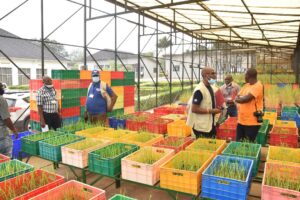
At a time when the world food supply continues to be outpaced by a growing population and consumption, boosting grain production has emerged as a top priority among governments. The first Postharvest Rice Conference and Exhibition held last 15 to 17 July in Bangkok, Thailand, was thus very timely in highlighting the importance of postharvest activities in the rice production chain and in achieving food security. Jointly organized by the International Rice Research Institute and Asia Congress Events Co., Ltd., the conference brought together leading researchers and experts in postharvest. It also featured service providers and equipment suppliers (such as GrainPro, Buhler, Satake, FrigorTec, etc.) that are leading companies in postharvest technological innovations.
Countries did not take real notice of agriculture’s importance until the food crisis of 2008. Since then, leaders have put more effort and investments into farming to increase yield, particularly that of rice, the staple food of around half of the world’s population. Now, the world produces rice at a 1% annual growth rate. However, Dr. Samarendu Mohanty, head of IRRI’s Social Sciences Division, revealed that yield growth must step up to 1.2–1.5% a year if the world intends to keep up with increasing demand. What many fail to consider, though, is that improving yield growth has never really just been about planting the cereal and harvesting it. The postharvest process is just as crucial, as how the grains are handled at this stage makes a lot of difference in the amount of rice that is actually available for consumption.
Lost grains

According to Martin Gummert, IRRI postharvest specialist, 15–20% of rice grains are lost during postharvest. These losses are often caused by delays in the postharvest chain resulting from labor shortage, unsuitable traditional sun-drying practices, pests, moisture absorption in traditional open-storage systems, as well as from outdated and poorly maintained rice mills that yield as low as 60%, and drastically reduce head rice (see Working together to save grains on pages 20-21 ofRice Today Vol. 8, No. 3). Engr. Carlito Balingbing, an assistant scientist at IRRI, even noted that poor postharvest management operations expose grains to unfavorable environmental conditions that could cause fungal contamination such as mycotoxins, and further losses.
Although research has produced many new postharvest technology concepts, adoption and commercialization have been slow for many reasons. Among them are technologies not matched to users’ needs or targeting the wrong users; limited understanding of quality and losses, and how these are affected by postharvest management; lack of market incentives for better quality rice; and limitations in available financing schemes.
A new postharvest value chain approach including all postharvest stakeholders promoting improved postharvest management could speed up the modernization of the sector. Should improved postharvest technologies be adopted by farmers, Engr. Gummert advised that this equipment must be what farmers really need (not what intermediaries perceive that farmers need) and must be user-friendly enough for farmers to easily adapt to it and integrate it into their current rice production practices. Funding is also needed to help raise both knowledge and technology on farms and with other postharvest stakeholders and to sustain the adoption of this technology and improvements for it. Unfortunately, there has been significant disinvestment in public-sector postharvest research and development in the past. Recently, however, we have seen some donors showing renewed interest in reducing postharvest losses. The Asian Development Bank (ADB) and the Swiss Agency for Development and Cooperation (SDC) are currently funding the adaptation and out-scaling of improved postharvest technologies through IRRI and its national partners in Cambodia, Laos, Indonesia, Myanmar, Vietnam, and the Philippines.
Yield of edible rice
More than just losing a significant amount of grains, however, farmers also tend to lose grain quality in the postharvest process. Dr. Melissa Fitzgerald, IRRI grain quality specialist, raised this important question, “What use is high yield if it cannot be eaten or sold?” She said that the two things that determine the value of rice in the domestic and international markets are the proportion of broken grains and the rice’s “chalkiness.” Improper postharvest activities are one of the key causes of grain breakage. If the grain is densely packed with good-sized starch granules, it is much more likely to withstand postharvest processes.

Chalk, or the white spot on the grain, is caused by air spaces between the starch granules, which make the grain fragile and easy to break. Chalkiness reduces the value of the rice by 25% or more and decreases head rice yield. Dr. Fitzgerald pointed out that an increase in chalkiness decreases the acceptability of the rice, which would consequently spell a marked reduction in financial return to farmers. Chalk is induced by high temperatures; so, rice production faces a further threat with global warming.
IRRI’s Grain Quality, Nutrition, and Postharvest Center is trying to develop markers (see On your mark, get set, select on pages 28-29 of Rice Today Vol. 3, No. 3) in rice’s genetic makeup that will enable plant breeders to develop varieties that will be translucent (not chalky) and more resistant to grain breakage. IRRI hopes to go beyond just increasing paddy yield to increasing the “yield of edible rice.” Dr. Fitzgerald said that “yield as paddy means nothing to farmers, consumers, or marketers if grains like these (chalky and broken) are beneath the hulls. The Australian Centre for International Agricultural Research is currently funding this work.”





